|
International Women’s Day is March 8, and this year’s theme is “DigitALL: Innovation and technology for gender equality.” This theme is based on the United Nations 67th Commission on the Status of Women priority theme “Innovation and technological change, and education in the digital age for achieving gender equality and the empowerment of all women and girls.”
Even as technological innovation has demonstrated tremendous potential to amplify women’s voices, misuse of social media and other digital technologies has led to the scourge of technology-facilitated gender-based violence (TFGBV). Recognizing both the positive potential and risks of new digital technologies, particularly as they relate to vulnerable and marginalized populations, USAID’s Digital Strategy includes a commitment to “close the gender digital divide and address the disproportionate harm women and girls face online.” The U.S. Government-led Global Partnership for Action on Gender-Based Online Harassment and Abuse was initiated to bring together countries, international organizations, civil society, and the private sector to address this issue, which is both a threat to democracy and a tool of authoritarian governments, and an obstacle for equity in political participation everywhere.
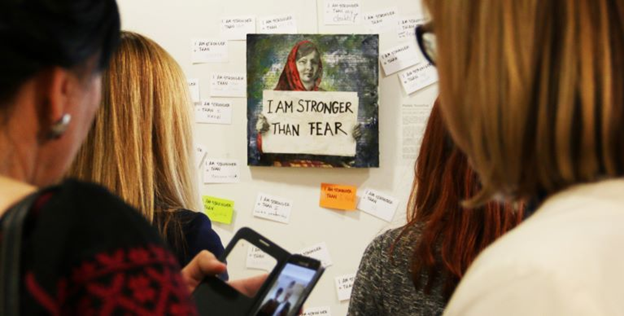 USAID’s new Transform Digital Spaces to Reflect Feminist Democratic Principles program launched in November 2022.
This edition of the DRG Learning Digest examines the following topics:
- Women in politics and public life frequently face gender-based violence (GBV)
- GBV facilitated by technology: high speed and broad scale
- Innovations for prevention and response to TFGBV in politics and public life
Please make use of DRG Evidence and Learning Team resources! (See text box at the end.)
Women in Politics and Public Life Frequently Face GBV
Due to the public nature of their work, women as well as non-binary candidates for office, politicians, political party supporters, voters, government officials, activists, human rights defenders, journalists, and social leaders are vulnerable to being targeted for TFGBV. Violence against women in politics and public life (VAWPP) is a conscious tactic used to undermine women's ability to participate in politics. As such, it threatens democracy by targeting, undermining, and inhibiting the participation of women in the political and the public sphere.
VAWPP tactics include psychological abuse, economic coercion, physical and sexual assault, and increasingly TFGBV. As defined by UN Women, violence against women in politics has three distinct characteristics: it targets women explicitly because of their gender; its forms are gendered, as exemplified by sexist threats and sexual violence; and its impact is to discourage women from being or becoming politically active. This targeted violence and harassment is intersectional, and is experienced differently by different racial, religious, and other identities. A study of female parliamentarians from 39 countries by the Inter-Parliamentary Union in 2016 found that 82 percent of respondents experienced psychological violence, including 44 percent of those surveyed reporting they have received threats of death, rape, beatings, or abduction during their parliamentary term. A 2018 National Democratic Institute (NDI) study on violence against women in political parties revealed that 20 percent of respondents had confronted physical violence while carrying out party functions, and 86 percent had experienced psychological violence, including threats and coercion in general.
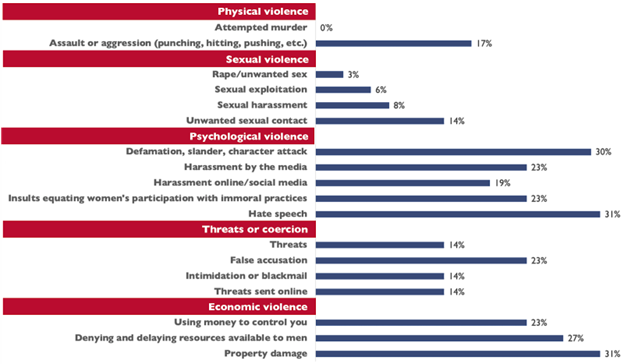 Prevalence of Various Forms of Violence Against Women in Political Parties. Source: 2018 NDI study, “No Party to Violence: Analyzing Violence Against Women in Political Parties.”
High-profile silencing and exclusion of women from political life is intended to send a message that women as a group do not have a role in political processes. Regressive social policies that promote a return to traditional gender roles can further encourage it, as was seen in the highly violent and sexist rhetoric and symbols used in the impeachment campaign against Brazil’s first female president, Dilma Rousseff. Many believe hers was a case of “gender ideology” mobilized as a political strategy beyond the scope of specific law or policy, aiming to delegitimize political actors and alternatives — mirrored, too, in more recent examples of the decision of 18 female members of Britain's Parliament in 2019 who decided not to run for re-election, stating that the abuse experienced online and offline factored into their decisions and of New Zealand’s Prime Minister Jacinda Ardern, who stepped down amid an environment of hostility and violence. This can silence women’s voices, force individuals to drop out of political life, or discourage young women from entering politics or engaging in other forms of activism. In doing so, it threatens electoral processes and the very credibility of institutions. The current rise in authoritarianism strengthens the conditions for VAWPP. Authoritarian governments frequently use it to suppress women’s votes, constrain the diversity of views, and maintain the status quo.
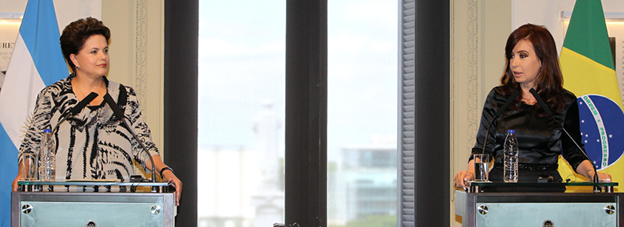 At left, Dilma Rousseff, Brazil’s first female president, speaks with the second female president of Argentina, Cristina Fernández de Kirchner. Photo: Palácio do Planalto.
GBV Facilitated by Technology: High Speed and Broad Scale
"All technologies … are neither good nor bad, but never neutral, and they amplify the power of those that control them." –Emrys Schoemaker
The very technologies with the potential to expand the reach and voice of those traditionally without power also provide new forms and platforms for VAWPP, increasing perpetrators’ reach and impact while enabling them to act anonymously and often without consequences. TFGBV includes a wide range of acts including cyberstalking, sextortion, doxing, the non-consensual distribution of intimate digital images, malicious deep fakes, livestreamed sexual violence, rape and death threats, disinformation, and intimate-partner violence. Some forms are criminal; others are not but nonetheless succeed at silencing women and girls. Younger women, women from marginalized racial and ethnic groups, women with disabilities, and members of the LBGTQI+ community are more likely to be targeted than those of other identities, and they experience different threats including racist and homophobic attacks. The scale and speed at which TFGBV takes place makes it one of the most troubling forms of VAWPP occurring today.
One form of TFGBV that targets women in public life in particular is gendered disinformation. Gendered disinformation leverages gender norms to manipulate political outcomes through campaigns that may feature fake stories, threats, and sexually charged or humiliating images. A Brookings report identifies gendered disinformation as a national security problem, noting that the goal of these attacks is to frame female politicians and government officials as inherently untrustworthy, unintelligent, or too emotional or libidinous to hold office or participate in democratic politics. This distorts public understanding of women’s achievements, and discourages other women from entering public life.
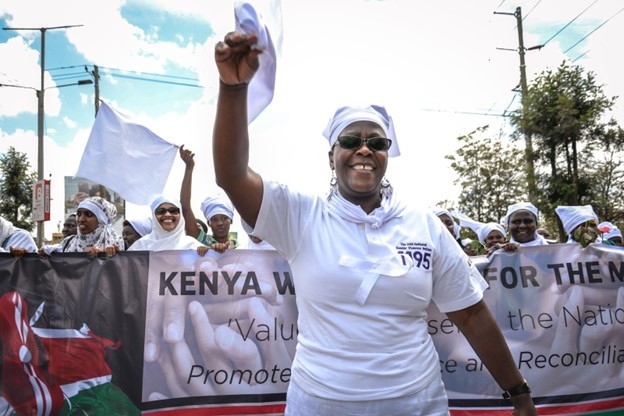 Fanis Lisiagali, Executive Director of Healthcare Assistance Kenya, leads the White Ribbon Campaign march to promote their rapid response call center hotline that responds to violence against women in elections in Nairobi, Kenya (Source: USAID/Kenya’s Electoral Assistance Program, implemented by the International Foundation for Electoral Systems (IFES). Photo: Carla Chianese, IFES
TFGBV that targets women in politics and public life violates women’s human rights, not only to a life free of gender-based violence, but also to participate in peaceful activities and to freedom of expression and opinion. It also threatens to limit the scope of women’s engagement in politics, as those who speak on issues of equity and human rights are at increased risk of violence both online and offline, particularly when they defy cultural, religious, or social norms about femininity and the role of women. TFGBV makes it more challenging for female politicians to use online platforms to interact with their constituents, impacting their ability to compete and making them less effective at representing the interests of their constituency, which may lead to further silencing of marginalized groups represented by these women. It has a chilling effect on women’s political participation in both the present and the future, as witnessing or experiencing TFGBV can discourage girls and young women from pursuing public life and lower their participation in civic and political debate.
USAID is developing programs to address TFGBV against women in politics and public life. “Transform” (Transform Digital Spaces to Reflect Feminist Democratic Principles) is a three-year global pilot initiative to expand opportunities for women to participate in and lead political processes by addressing the causes and responses to TFGBV. The pilot initiatives will use a whole-of-system approach with the frame that this issue impacts not only individual survivors, but also is used as a tool by anti-democratic actors for repression.
Innovations for Prevention and Response to TFGBV in Politics and Public Life
Researchers and organizations are doing significant work to understand TFGBV in politics and public life as a problem distinct from broader gender-based and political violence, and developing innovative strategies and tools to address the challenge. NDI developed a set of recommendations for ending TFGBV through its #NotTheCost initiative, which includes raising awareness, data collection, networking, and training. The UN Population Fund published “Making All Spaces Safe,” a guide that includes sets of recommendations for governments and technology companies to make online spaces safe for women and girls, such as regulating private technology companies to enforce safety and response mechanisms and holding perpetrators to account.
Supporting survivors is another key strategy for combating TFGBV in politics and public life. USAID-supported research published in December 2022 in the Journal of Gender-Based Violence studied the help-seeking behaviors of TFGBV survivors in Asia, and found that the three most common places survivors seek support are technology companies, government and legal systems, and social support systems — but encounter significant knowledge and cultural barriers. One technological solution to supporting survivors is Bloom, an online platform for survivors of technology-facilitated and other types of GBV created by the nonprofit organization Chayn. Bloom informs and empowers survivors by offering open, online resources and services that are trauma-informed, intersectional, multilingual, and feminist.
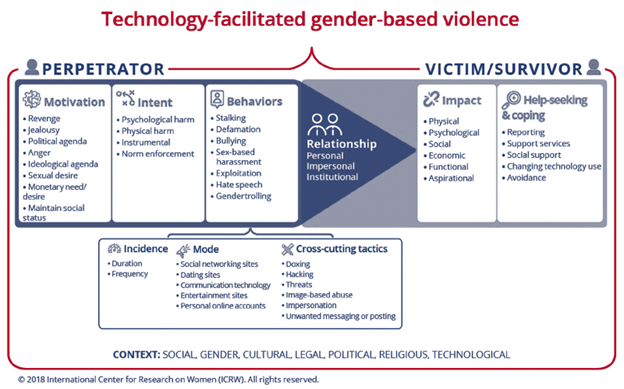 TFGBV conceptual framework developed by the International Center for Research on Women (ICRW). Source: Bansal et. al. (2022), Journal of Gender-Based Violence.
Tech itself has a role to play in combating TFGBV. A team of women in India developed Uli, a web browser plug-in that uses artificial intelligence (AI) to redact abusive content from Twitter. Uli is aimed at persons of marginalized gender who have an active, assertive presence on Twitter and are targeted for their opinions. Another tool, Bumble’s “private detector,” uses AI to automatically blur sexualized images before letting the user know they were sent something potentially inappropriate. Bumble recently made this tool open-source for other platforms.
The End Cyber Abuse coalition developed a global field guide to advance intersectional, survivor-centered, and trauma-informed interventions for TFGBV. The guide proposes alternative business and governance models for technology companies, open source technologies, and diverse, inclusive teams and management structures, and also includes resources for technology designers, including Design Justice, Design for Safety, and Feminist Tech Principles.
Finally, the Global Disinformation Index can help keep private companies accountable by producing risk ratings of various websites and sharing them with advertising technology companies to ensure that advertiser money and brands are not supporting violence, harmful content, and defamation. Though not specific to violence against women in politics and public life, this is a critical tool for reforming the current technology business model, which tends to prioritize engagement over quality of content and safety of users, encouraging the wider public reckoning that will be needed to counter the scourge of TFGBV both in and out of politics.
Further Assistance
You can learn more about technology-facilitated gender-based violence in politics and other resources found in this Learning Digest by contacting the DRG Center’s Senior Gender Advisor Caroline Hubbard (chubbard@usaid.gov) or the Evidence and Learning Team (ddi.drg.elmaillist@usaid.gov).
Recent DRG Learning Events
DRG Evidence and Learning Talk Series: Foreign Funding Flows and People’s Perceptions of Donors, Domestic Governments, and Development Interventions
Many international development agencies undertake extensive branding activities in order to spread information about the role that they play in bringing various development interventions to fruition. On February 2, the DRG Center hosted Matthew Winters, from the University of Illinois, to discuss his research on the effectiveness of this communication. His research in Bangladesh and Uganda found that individuals in aid-receiving countries who received information about foreign funding reported (1) more positive attitudes toward the donor; (2) more positive attitudes toward their own government; and (3) more positive attitudes toward the development intervention. However, despite extensive branding campaigns, baseline awareness of foreign funding is low.
Fostering Democratic Advances: Unleashing the Potential of Public Audits
Supreme Audit Institutions (SAIs) face serious limitations in many countries. As the Open Budget Survey shows, audit reports are withheld from the public, hearings on audit findings take place behind closed doors, and recommendations for reforms to meet the needs of citizens and deliver results are not acted upon. On February 14, Claire Schouten from the International Budget Partnership, Francisco Rodriguez Abinal from Asociación Civil por la Igualdad y la Justicia, and Krishna Sapkota from the Freedom Forum joined the DRG Center to discuss the International Budget Partnership’s (IBP) Audit Accountability Initiative, a multi-country project (May 2019-January 2022) that brought together SAIs and civil society organizations (CSOs) in five target countries (Argentina, Ghana, Nepal, Sierra Leone, and Tanzania) to enhance government responsiveness to previously ignored audit findings, including in key sectors such as health, education, and water and sanitation. The project demonstrated that by using their broad networks and relationships with media, CSOs were able to build alliances and grassroots pressure for the government to address audit recommendations.
DRG Evidence and Learning Talk Series: Lessons for Donors from “Sandwich Strategy” Reforms
Donors and policy reformers often make bold promises to improve government responsiveness to citizen voice. Yet such proclaimed openings from above often fall short, get diverted, or are blocked. On February 27, Jonathan Fox and Rachel Robinson from American University presented findings from a recent study that compares a set of 19 diverse reform initiatives that delivered tangible openings to enable collective action for socially excluded groups. Half of the cases led to at least incremental pro-reform shifts in the balance of power – often below the radar and in spite of obstacles, backlash, or partial rollback. They find that donors often played key enabling roles, bolstering reform innovation as convenors and brokers as well as funders. Lessons for donors include: providing flexible funding targeted to reform openings; investments in broad and intensive frontline field presence for reform agencies; and support for the organization and institutionalized representation of the socially excluded. Donors can mitigate effects of likely backlash and reformists' loss of power by investing in hybrid, state-society institutions with subnational foundations.
Use Our Resources!
Welcome to the DRG Learning Digest, a newsletter to keep you informed of the latest learning, evaluation, and research in the Democracy, Human Rights, and Governance (DRG) sector. Views expressed in the external (non-USAID) publications linked in this Digest do not necessarily represent the views of the United States Agency for International Development or the United States Government.
Don't forget to check out our DRG Learning Menu of Services! (Link only accessible to USAID personnel.) The Menu provides information on the learning products and services the Evidence and Learning Team offers to help you fulfill your DRG learning needs. We want to help you adopt learning approaches that emphasize best fit and quality.
The Evidence and Learning Team is also excited to share our DRG Learning, Evidence, and Analysis Platform (LEAP) with you. This Platform contains an inventory of programmatic approaches, evidence gap maps, the DRG Learning Harvest, and inventories of indicators and country data portraits - all of which can be very useful in DRG activity design, implementation, evaluation, and adaptation. Some of these resources are still being built, so check back frequently to see what has been newly added.
The DRG Learning Harvest on LEAP is a searchable database of DRG learning products, including summaries of key findings and recommendations, drop-down menus to easily find documents related to a particular country or program area, and links to the full reports on the DEC.
Our friends at the Varieties of Democracy (V-Dem) Institute are also seeking to expand their research partnership with USAID on the complex nature of democracy by inviting research questions from you for V-Dem to work on. If there's a DRG technical question you've been wondering about, please email the Evidence and Learning Team at ddi.drg.elmaillist@usaid.gov.
We welcome your feedback on this newsletter and on our efforts to promote the accessibility, dissemination, and utilization of DRG evidence and research. Please visit the DRG Center's website for additional information or contact us at ddi.drg.elmaillist@usaid.gov.
|